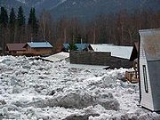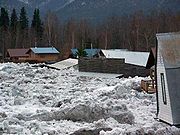
Ice dam
Encyclopedia
An ice dam occurs when water builds up behind a blockage of ice. Ice dams can occur in various ways.
In modern times, the Hubbard Glacier
regularly blocks the mouth of Russell Fjord at 60° north on the coast of Alaska
.
A similar event takes place after irregular periods in the Perito Moreno Glacier, located in Patagonia
. Every four years the glacier forms an ice dam against the rocky coast, causing the waters of the Argentine Lake to rise. When the water pressure is too high, then the giant bridge collapses in what has become a major tourist attraction. This sequence occurred last on March 13, 2006, preceding the previous which took place only two years before, on March 12, 2004.
About 13,000 years ago, the Cordilleran ice sheet
crept southward into the Idaho Panhandle
, forming a large ice dam that blocked the mouth of the Clark Fork River, creating a massive lake 2000 feet (609.6 m) deep and containing more than 500 cubic miles (2,084.1 km³) of water. Finally this Glacial Lake Missoula
burst through the ice dam and exploded downstream, flowing at a rate 10 times the combined flow of all the rivers of the world. Because such ice dams can re-form, such Columbia River
floods happened at least 59 times, carving Dry Falls
below Grand Coulee
.
 If the upstream part of a river thaws first (possibly because it flows away from the equator), and the ice gets carried downstream into the still-frozen part, the ice can form an ice dam and flood the areas upstream of the jam. This occurred during the 2009 Red River Flood
If the upstream part of a river thaws first (possibly because it flows away from the equator), and the ice gets carried downstream into the still-frozen part, the ice can form an ice dam and flood the areas upstream of the jam. This occurred during the 2009 Red River Flood
and the 2009 Alaska floods
. After the ice dam breaks apart, the sudden surge of water that breaks through the dam can then flood areas downstream of the jam. While this usually occurs in spring, it can happen as winter sets in when the downstream part becomes frozen first. Where floods threaten human habitation, the blockage may be artificially cleared. Ice blasting
using dynamite
, or other mechanical means may be used.
of a house with inadequate insulation
. Heat conducted through the insufficient insulation and warm air from the attic bypasses warms the roof and melts the snow on those areas of the roof that are above living spaces, but does not melt the snow on roof overhangs. Meltwater flows down the roof, under the blanket of snow, onto the eave and into the gutter, where colder conditions on the overhang cause it to freeze. Eventually, ice accumulates along the eave and in the gutter. Snow that melts later cannot drain properly through the ice on the eave and in the gutter, resulting in leaks to the roof space resulting in damaged ceilings, walls, roof structure and insulation.
Caused by a glacier
Sometimes a glacier flows down a valley to a confluence where the other branch carries an unfrozen river. The glacier blocks the river, which backs up into a lake, which eventually overflows or undermines the ice dam, suddenly releasing the impounded water.In modern times, the Hubbard Glacier
Hubbard Glacier
Hubbard Glacier is a glacier located in eastern Alaska and part of Canada.The longest source for Hubbard Glacier originates from its snout and is located at about at about , approximately west of Mt. Walsh with an altitude around . A shorter tributary glacier begins at the easternmost summit on...
regularly blocks the mouth of Russell Fjord at 60° north on the coast of Alaska
Alaska
Alaska is the largest state in the United States by area. It is situated in the northwest extremity of the North American continent, with Canada to the east, the Arctic Ocean to the north, and the Pacific Ocean to the west and south, with Russia further west across the Bering Strait...
.
A similar event takes place after irregular periods in the Perito Moreno Glacier, located in Patagonia
Patagonia
Patagonia is a region located in Argentina and Chile, integrating the southernmost section of the Andes mountains to the southwest towards the Pacific ocean and from the east of the cordillera to the valleys it follows south through Colorado River towards Carmen de Patagones in the Atlantic Ocean...
. Every four years the glacier forms an ice dam against the rocky coast, causing the waters of the Argentine Lake to rise. When the water pressure is too high, then the giant bridge collapses in what has become a major tourist attraction. This sequence occurred last on March 13, 2006, preceding the previous which took place only two years before, on March 12, 2004.
About 13,000 years ago, the Cordilleran ice sheet
Cordilleran Ice Sheet
The Cordilleran ice sheet was a major ice sheet that covered, during glacial periods of the Quaternary, a large area of North America. This included the following areas:*Western Montana*The Idaho Panhandle...
crept southward into the Idaho Panhandle
Idaho Panhandle
The Idaho Panhandle is the northern region of the U.S. State of Idaho that encompasses the ten northernmost counties of Benewah, Bonner, Boundary, Clearwater, Idaho, Kootenai, Latah, Lewis, Nez Perce, Shoshone. Residents of the panhandle refer to the region as North Idaho...
, forming a large ice dam that blocked the mouth of the Clark Fork River, creating a massive lake 2000 feet (609.6 m) deep and containing more than 500 cubic miles (2,084.1 km³) of water. Finally this Glacial Lake Missoula
Glacial Lake Missoula
Glacial Lake Missoula was a prehistoric proglacial lake in western Montana that existed periodically at the end of the last ice age between 15,000 and 13,000 years ago...
burst through the ice dam and exploded downstream, flowing at a rate 10 times the combined flow of all the rivers of the world. Because such ice dams can re-form, such Columbia River
Columbia River
The Columbia River is the largest river in the Pacific Northwest region of North America. The river rises in the Rocky Mountains of British Columbia, Canada, flows northwest and then south into the U.S. state of Washington, then turns west to form most of the border between Washington and the state...
floods happened at least 59 times, carving Dry Falls
Dry Falls
Dry Falls is a 3.5 mile long scalloped precipice in central Washington, on the opposite side of the Upper Grand Coulee from the Columbia River, and at the head of the Lower Grand Coulee. Ten times the size of Niagara, Dry Falls is thought to be the greatest known waterfall that ever existed...
below Grand Coulee
Grand Coulee
The Grand Coulee is an ancient river bed in the U.S. state of Washington. This National Natural Landmark stretches for about sixty miles southwest from Grand Coulee Dam to Soap Lake, being bisected by Dry Falls into the Upper and Lower Grand Coulee....
.
On rivers

2009 Red River flood
The 2009 Red River flood along the Red River of the North in North Dakota and Minnesota in the United States and Manitoba in Canada brought record flood levels to the Fargo-Moorhead area. The flood was a result of saturated and frozen ground, Spring snowmelt exacerbated by additional rain and snow...
and the 2009 Alaska floods
2009 Alaska floods
The 2009 Alaska floods were a series of natural disasters taking place in the United States state of Alaska during April and May 2009. The floods are a result of heavier-than-typical winter snowfall and above-average spring temperatures that resulted in rapid melting of the winter snowfall...
. After the ice dam breaks apart, the sudden surge of water that breaks through the dam can then flood areas downstream of the jam. While this usually occurs in spring, it can happen as winter sets in when the downstream part becomes frozen first. Where floods threaten human habitation, the blockage may be artificially cleared. Ice blasting
Ice blasting
Ice blasting is the use of explosives to break up ice in rivers, greatly aiding navigation systems.This is done during the spring when snow is melting and river ice is breaking up. There is always a chance that the ice flows could collide creating an ice jam and blocking the river. The river,...
using dynamite
Dynamite
Dynamite is an explosive material based on nitroglycerin, initially using diatomaceous earth , or another absorbent substance such as powdered shells, clay, sawdust, or wood pulp. Dynamites using organic materials such as sawdust are less stable and such use has been generally discontinued...
, or other mechanical means may be used.
On roofs of buildings
An ice dam, on a smaller scale, is a problem of house and building maintenance in cold climates. An ice dam can occur when snow accumulates on the slanted roofRoof
A roof is the covering on the uppermost part of a building. A roof protects the building and its contents from the effects of weather. Structures that require roofs range from a letter box to a cathedral or stadium, dwellings being the most numerous....
of a house with inadequate insulation
Insulation
Insulation means:* Building insulation, added to buildings for comfort and energy efficiency* Soundproofing, also known as acoustic insulation, any means of reducing the intensity of sound...
. Heat conducted through the insufficient insulation and warm air from the attic bypasses warms the roof and melts the snow on those areas of the roof that are above living spaces, but does not melt the snow on roof overhangs. Meltwater flows down the roof, under the blanket of snow, onto the eave and into the gutter, where colder conditions on the overhang cause it to freeze. Eventually, ice accumulates along the eave and in the gutter. Snow that melts later cannot drain properly through the ice on the eave and in the gutter, resulting in leaks to the roof space resulting in damaged ceilings, walls, roof structure and insulation.
External links
- United States National Park Service
- More images
- CRREL's Ice Jam Database
- RoofIce Dam Images
- http://bct.eco.umass.edu/publications/by-title/preventing-ice-dams
- RoofIce Dam Melt Socks

